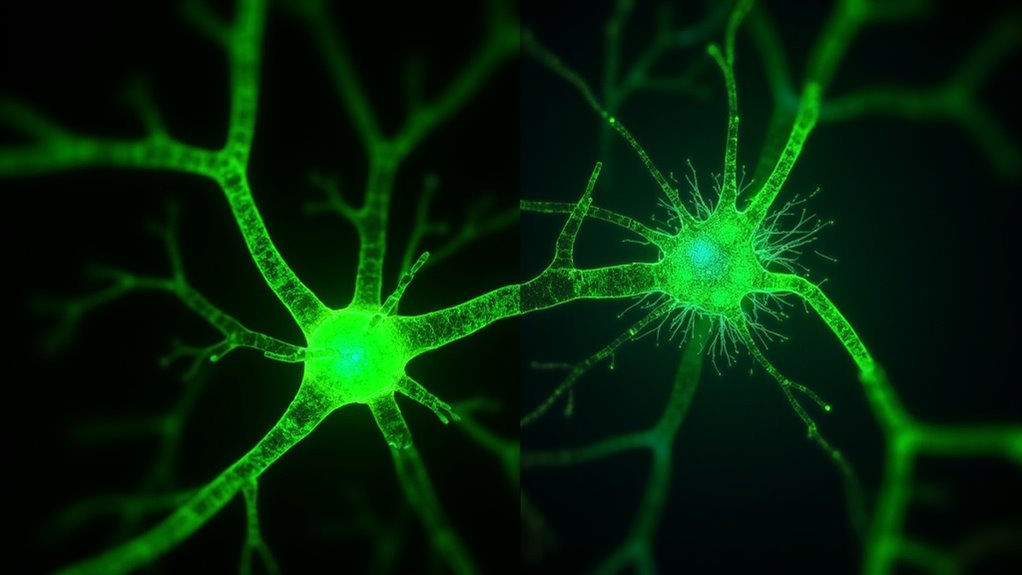Currently, there’s no cure for Parkinson’s disease, but you’ll find divergent treatment options focused on managing symptoms and potentially modifying disease progression. Your treatment plan will likely include dopamine replacement therapies as frontline medications, complemented by physical therapy and lifestyle modifications. While deep brain stimulation may help with severe symptoms, emerging research in gene therapies and stem cell transplants offers promising directions for future therapeutic interventions. Understanding the complete treatment horizon can help you navigate your options effectively.
Current Treatment Landscape for Parkinson’s Disease

While Parkinson’s disease remains incurable, modern medicine offers a thorough treatment approach focused on symptom management and disease modification. You’ll find that treatments for Parkinson’s primarily center on dopamine replacement therapies, with levodopa and dopamine agonists serving as frontline medications to control motor symptoms.
When your Parkinson’s symptoms become severe and resistant to medication, your healthcare team may recommend surgical interventions like deep brain stimulation. You can also complement pharmaceutical treatments with lifestyle modifications, including structured exercise programs and dietary adjustments. These interventions may help slow disease progression and amplify your quality of life.
It’s crucial to note that as Parkinson’s disease advances, you’ll likely need periodic adjustments to your treatment regimen, as medication effectiveness typically decreases over time.
Understanding Disease Progression and Challenges

The progressive nature of Parkinson’s disease presents complex challenges in treatment planning and patient care. You’ll notice that as the disease advances, your brain’s dopamine production markedly decreases, leading to increasingly severe symptoms. While treatments for Parkinson’s can help manage these symptoms, there’s currently no cure available.
| Disease Stage | Primary Challenges |
|---|---|
| Early | Motor symptoms begin, medication adjustment needed |
| Moderate | Treatment efficacy fluctuates, new symptoms emerge |
| Advanced | Drug resistance develops, increased care required |
| Late | Significant disability, complex management needs |
Understanding the progression of the disease is essential as you’ll experience both motor and non-motor symptoms that vary in intensity and timing. Your treatment plan will need regular adjustments to address changing symptoms and maintain optimal therapeutic outcomes, though medication effectiveness typically diminishes over time.
Latest Research Developments and Clinical Trials

Recent advances in Parkinson’s disease research have yielded promising therapeutic pathways through novel clinical trials and experimental treatments. International collaborations are accelerating the development of new treatments while optimizing resource allocation and research efficiency.
- Gene therapies and stem cell transplants represent cutting-edge experimental treatments targeting neurodegeneration and dopaminergic cell restoration
- Deep brain stimulation protocols and growth factor therapies show potential for neuroprotection and regeneration of affected neural pathways
- Large-scale clinical trials are evaluating drug repurposing strategies, investigating existing medications for novel therapeutic applications
- Research participation remains fundamental for advancing treatment protocols, with opportunities ranging from clinical trial enrollment to supporting foundations through monthly contributions
These developments suggest a shift from singular cure pursuit to developing targeted, personalized therapeutic interventions for symptom management and disease modification.
Emerging Therapeutic Approaches
Stem cell therapy research has demonstrated promising results in neuronal regeneration and dopamine production, with multiple clinical trials showing potential for tissue restoration in Parkinson’s patients. You’ll find significant breakthroughs in both autologous and allogeneic stem cell treatments, where researchers have successfully developed methods to differentiate stem cells into dopamine-producing neurons. Clinical trials utilizing these advanced therapeutic approaches have shown measurable improvements in motor function and reduced disease progression in select patient populations, though larger-scale validation studies are still ongoing.
Stem Cell Treatment Progress
Breakthrough advances in regenerative medicine have brought stem cell therapy to the forefront of Parkinson’s disease treatment research. You’ll find ongoing clinical trials evaluating diverse stem cell types as potential disease-modifying therapy options, targeting the replacement of lost dopaminergic neurons.
While research shows promise, scientists must overcome several critical challenges:
- Ensuring precise differentiation of transplanted stem cells into functional dopamine-producing neurons
- Developing effective methods to deliver stem cells across the blood-brain barrier
- Controlling potential immune rejection responses to transplanted cells
- Optimizing cell survival rates post-transplantation
Preclinical studies in animal models demonstrate significant improvements in motor function and dopamine levels following stem cell interventions. Though still experimental, these therapeutic approaches offer a potential paradigm shift from symptom management to actual disease modification.
Clinical Trial Breakthroughs
Major clinical trials investigating novel therapeutic approaches are transforming the terrain of Parkinson’s disease treatment. You’ll find groundbreaking developments in stem cell therapies and gene therapies that aim to halt or reverse disease progression, rather than merely managing symptoms.
Clinical trials are advancing on multiple fronts: testing medications to reduce dyskinesia complications, evaluating therapies for Parkinson’s-related hallucinations, and exploring drug repurposing strategies for falls and cognitive decline. International research collaborations are streamlining the clinical trial process, making it more efficient and cost-effective.
These therapeutic innovations represent a shift from traditional symptom management to potentially disease-modifying treatments. You’re witnessing a pivotal moment in Parkinson’s research where multiple clinical trials are simultaneously targeting different aspects of the disease, increasing the likelihood of breakthrough treatments.
Quality of Life Management Strategies
While Parkinson’s disease currently has no cure, extensive quality of life management strategies play a crucial role in maintaining patient autonomy and functional capacity. Through targeted lifestyle changes, you’ll find all-encompassing approaches that address both physical and psychological aspects of disease management.
Managing Parkinson’s requires a holistic approach, combining physical and psychological strategies to preserve independence and daily function.
- Physical therapy and occupational therapy interventions boost mobility, strength, and daily function, allowing you to maintain independence in activities of daily living.
- Speech therapy techniques improve communication abilities and swallowing function, reducing complications and social isolation.
- Nutritional counseling and dietary modifications help optimize medication effectiveness and manage gastrointestinal symptoms.
- Support systems, including counseling and group therapy, provide essential emotional support while assistive devices elevate safety during mobility and self-care tasks.
These evidence-based interventions, when implemented systematically, can substantially improve your quality of life while living with Parkinson’s disease.
Future Directions in Parkinson’s Research
Scientific advancements in Parkinson’s disease research have opened promising avenues for therapeutic interventions beyond current management strategies. You’ll find researchers exploring groundbreaking approaches including gene therapies, stem cell treatments, and growth factors that could potentially modify disease progression.
International research initiatives, like the Parkinson’s Virtual Biotech, are accelerating treatment development through collaborative efforts. Scientists are investigating drug repurposing opportunities to address complex symptoms such as hallucinations and falls. These pioneering approaches may offer more targeted interventions for the diverse manifestations of Parkinson’s disease.
Your involvement can drive this momentum forward. By participating in clinical trials or providing financial support through monthly donations, you’re contributing to critical research that’s essential for developing transformative treatments and potential cures for Parkinson’s disease.
Frequently Asked Questions
What Happens if You Take Carbidopa Levodopa and You Don’t Have Parkinson’s?
If you take carbidopa-levodopa without having Parkinson’s disease, you’ll experience adverse side effects without any therapeutic benefit. You may develop nausea, vomiting, confusion, and lightheadedness due to dosage concerns affecting your brain’s dopamine system. There’s also a risk of drug interactions with other medications you might be taking. Additionally, you could develop dependency issues. It’s essential to only take this medication with a confirmed Parkinson’s diagnosis and proper medical supervision.
What Is the Best Way to Help Parkinson’s Disease?
To optimize your Parkinson’s disease management, you’ll need a thorough, multi-modal approach. Start with proper medication management, including carefully timed doses of medications like levodopa. Combine this with regular physical therapy to maintain mobility and balance, and occupational therapy to preserve daily living skills. You’ll also benefit from speech therapy, regular exercise, and maintaining a consistent sleep schedule. Work closely with your healthcare team to adjust interventions as symptoms evolve.
How Long Can You Live a Normal Life With Parkinson’s Disease?
With Parkinson’s disease, your life expectancy may be reduced by 7-14 years compared to the general population, though disease progression varies considerably among individuals. You can maintain a relatively normal quality of life for many years after diagnosis with proper medical management. Your specific prognosis depends on factors like timing of onset, symptom severity, and treatment adherence. Most patients can sustain independent living and regular activities for an extended period.
Can People With Parkinson’s Take Care of Themselves?
You can maintain self-care capabilities with Parkinson’s disease through strategic adaptations. By implementing daily living adaptations like grab bars, specialized utensils, and mobility aids, you’ll optimize independence. Self-care strategies including medication management, exercise routines, and therapeutic interventions help preserve autonomy. While caregiver support may become necessary as symptoms progress, many individuals successfully manage personal care tasks independently, especially in early disease stages with proper medical oversight and adaptive techniques.






